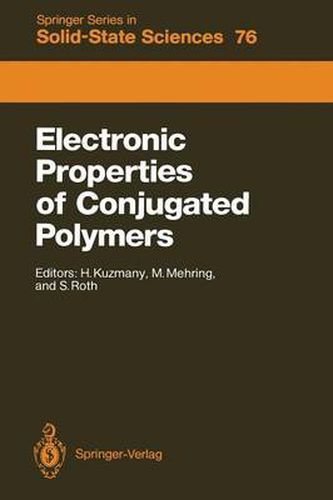Readings Newsletter
Become a Readings Member to make your shopping experience even easier.
Sign in or sign up for free!
You’re not far away from qualifying for FREE standard shipping within Australia
You’ve qualified for FREE standard shipping within Australia
The cart is loading…






This title is printed to order. This book may have been self-published. If so, we cannot guarantee the quality of the content. In the main most books will have gone through the editing process however some may not. We therefore suggest that you be aware of this before ordering this book. If in doubt check either the author or publisher’s details as we are unable to accept any returns unless they are faulty. Please contact us if you have any questions.
The International Winter School on Electronic Properties of Conjugated Polymers held March 14-21,1987, in Kirchberg (Austria) was a sequel to a meeting held in Kirchberg two years before on a similar subject. The 1987 winter school was organized in cooperation with the Bundesministerium fiir Wissenschaft und Forschung in Austria and the Bundesministerium fiir Forschung und Technologie in the Federal Republic of Germany. The basic idea of the meeting was to provide an opportunity for experienced scientists from universities and industry to discuss their most recent re- sults and for students and young scientists to inform themselves about the present state of the research in this field. As in 1985, the scientific interest was concentrated on the electronic structure of various conjugated polymers and related compounds. The focus of interest in the field now appears to have broadened and cov- ers not only conductivity and relaxation phenomena of polyacetylene but also nonlinear optical properties, highly oriented and single-crystal poly- mers, and electrochemical and opto-electrochemical properties of special materials such as polypyrrole and polyaniline. Exciting results on conduc- tivity - the mass specific conductivity (i.e., the conductivity divided by the density) of polyacetylene is more than twice that of copper (!) - and a detailed interpretation of the meaning of conjugation length are reported.
$9.00 standard shipping within Australia
FREE standard shipping within Australia for orders over $100.00
Express & International shipping calculated at checkout
This title is printed to order. This book may have been self-published. If so, we cannot guarantee the quality of the content. In the main most books will have gone through the editing process however some may not. We therefore suggest that you be aware of this before ordering this book. If in doubt check either the author or publisher’s details as we are unable to accept any returns unless they are faulty. Please contact us if you have any questions.
The International Winter School on Electronic Properties of Conjugated Polymers held March 14-21,1987, in Kirchberg (Austria) was a sequel to a meeting held in Kirchberg two years before on a similar subject. The 1987 winter school was organized in cooperation with the Bundesministerium fiir Wissenschaft und Forschung in Austria and the Bundesministerium fiir Forschung und Technologie in the Federal Republic of Germany. The basic idea of the meeting was to provide an opportunity for experienced scientists from universities and industry to discuss their most recent re- sults and for students and young scientists to inform themselves about the present state of the research in this field. As in 1985, the scientific interest was concentrated on the electronic structure of various conjugated polymers and related compounds. The focus of interest in the field now appears to have broadened and cov- ers not only conductivity and relaxation phenomena of polyacetylene but also nonlinear optical properties, highly oriented and single-crystal poly- mers, and electrochemical and opto-electrochemical properties of special materials such as polypyrrole and polyaniline. Exciting results on conduc- tivity - the mass specific conductivity (i.e., the conductivity divided by the density) of polyacetylene is more than twice that of copper (!) - and a detailed interpretation of the meaning of conjugation length are reported.